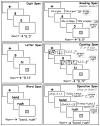The structure of working memory abilities across the adult life span
- PMID: 21299306
- PMCID: PMC3062735
- DOI: 10.1037/a0021483
The structure of working memory abilities across the adult life span
Abstract
The present study addresses three questions regarding age differences in working memory: (1) whether performance on complex span tasks decreases as a function of age at a faster rate than performance on simple span tasks; (2) whether spatial working memory decreases at a faster rate than verbal working memory; and (3) whether the structure of working memory abilities is different for different age groups. Adults, ages 20-89 (n = 388), performed three simple and three complex verbal span tasks and three simple and three complex spatial memory tasks. Performance on the spatial tasks decreased at faster rates as a function of age than performance on the verbal tasks, but within each domain, performance on complex and simple span tasks decreased at the same rates. Confirmatory factor analyses revealed that domain-differentiated models yielded better fits than models involving domain-general constructs, providing further evidence of the need to distinguish verbal and spatial working memory abilities. Regardless of which domain-differentiated model was examined, and despite the faster rates of decrease in the spatial domain, age group comparisons revealed that the factor structure of working memory abilities was highly similar in younger and older adults and showed no evidence of age-related dedifferentiation.
(c) 2011 APA, all rights reserved.
Figures







References
-
- Ackerman PL, Beier ME, Boyle MO. Working memory and intelligence: The same or different constructs? Psychological Bulletin. 2005;131:30–60. - PubMed
-
- Akaike H. Information theory and an extension of the maximum likelihood principle. In: Petrov BN, Csaki F, editors. Second international symposium on information theory. Budapest: Academiai Kiado; 1973. pp. 267–281.
-
- Akaike H. Factor analysis and AIC. Psychometrika. 1987;52:317–332.
-
- Alloway TP, Gathercole SE, Pickering SJ. Verbal and visuospatial short-term and working memory in children: Are they separable? Child Development. 2006;77:1698–1716. - PubMed
-
- Arbuckle TY, Maag U, Pushkar D, Chaikelson JS. Individual differences in trajectory of intellectual development over 45 years of adulthood. Psychology and Aging. 1998;13:663–675. - PubMed

